Heating your home should be done wisely: what should you consider when choosing a coolant for your heating system?
You are viewing the section Coolant, located in the large section System components.
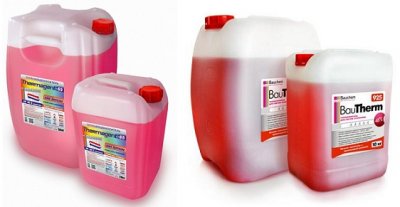
The following are used as heat carriers for heating systems: freezing and non-freezing liquids.
The first type includes water, and the second type includes alcohol-based compounds (antifreezes), to which special substances are added. additives, which form certain properties of the liquid.
Content
Requirements for the coolant for water heating
To choose the right heat carrier, it is worth considering the basic requirements that apply to it:
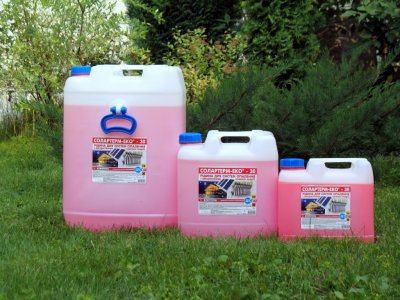
-
Coolant shouldn't be toxic, because leaks may occur in the system from time to time, and repairs should not be associated with a health hazard.
The use of flammable and explosive substances as heating liquid is also prohibited.
- High heat capacity, which ensures efficient heat transfer from the boiler to the radiators.
- Temperature spread from freezing point to boiling point should be as large as possible to minimize the likelihood of accidents.
- Liquid should not corrode seals or lead to corrosion in pipes and radiators.
When is it better to use water in an open or closed type of heating
The ideal heat carrier for a wood or coal heating system is water. If a heating system is used closed type, then even a regular one will do for her tap water from the tap. It forms a very thin layer of scale on the pipes, but this happens only once after the circuit is filled with coolant. In a closed system, there is no liquid evaporation, and it is necessary to add it extremely rarely, and a small amount of sediment does not affect the efficiency of heating.
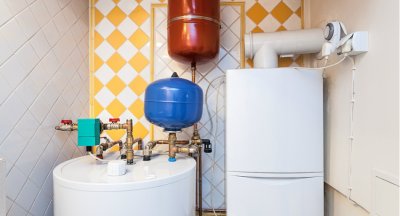
In the systems open type requires regular topping up of water, which means the amount of scale increases. To prevent this process, use distilled or purified water.
Distillate is sold in stores, but it is not cheap, so in practice filtered drinking water is often used instead.
The heat capacity of water is approximately 1 cal/g*°C, that is kilogram of water, heated up to 90 °C and cooled in the radiator up to 70 °C will give it to the premises 20 kcal of thermal energyIn this respect, water significantly surpasses all existing heat carriers.
Water has other benefits too:
- harmless for the health of people and animals;
- unconditional leadership in price and availability;
- unlimited service life in the system.
Water has one conditional disadvantage: if the heating system is not started when frost sets in, the water in it will freeze, which will lead to the destruction of pipes and the failure of the boiler. Therefore, in those systems where there is a possibility of downtime in winter, antifreeze is used as a coolant.
Application of antifreeze
Unlike water, antifreeze does not need to be drained from the heating system if it is not used in the winter, since antifreeze does not lose its fluidity at sub-zero temperatures. All antifreezes are substances based on polyhydric alcohols, their properties vary depending on their chemical composition. Other advantages of antifreezes include the following:
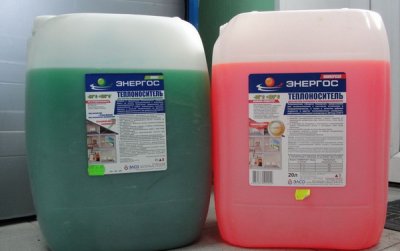
- Even if the temperature drops below the working level of the antifreeze, the latter does not harden or expand like water, so there is no damage to the heating system.
- Special additives are added to antifreezes, which reduce their chemical activity, suppress foaming and prevent scale formation within the system.
- Service life of all antifreezes up to 5 years, then they need to be replaced.
Despite all the advantages of antifreezes, they also have disadvantages:
- Heat capacity is approximately 15% lower, than water.
- Due to the increased viscosity, it is required more powerful circulation pump.
- Ethylene and propylene glycol have a destructive effect on zinc, so they should not be used in galvanized pipes.
Important! Not all brands of antifreeze can be used for electrode boilers. Before purchasing "antifreeze", carefully read the instructions for the boiler to find out which coolants can be used with it, otherwise the device will be removed from the warranty.
Based on ethylene glycol
Heat carriers based on ethylene glycol are inexpensive, but have a huge drawback - high toxicityPoisoning can occur not only when it enters the body, but also when the substance's vapors are inhaled or when it comes into contact with the skin.

Photo 1. Heat carrier based on ethylene glycol Argus-Galan, 20 kg, manufacturer - Galan, Russia.
This liquid is characterized by increased fluidity, therefore, at the slightest breach of tightness, it can leak out, which is dangerous for people and animals. Therefore, antifreezes of this type are used for heating non-residential premises, and other heat carriers are recommended for private houses.
Important! Categorically forbidden pour ethylene glycol-based antifreeze into open heating systems, where the toxic substance will evaporate from the expansion tank.
Such liquids are not used in dual-circuit systems where there is a possibility of them getting into hot water tanks.
Propylene glycol
Propylene glycol — a more “advanced” antifreeze. It is safe for the body, it can be found in some food products. Heat carriers of this type are allowed to be used in systems with double-circuit boilers, since their accidental entry into drinking water does not threaten human health.
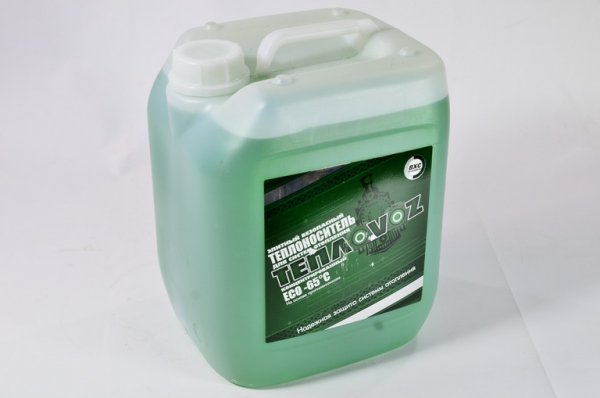
Photo 2. Non-freezing coolant based on propylene glycol ECO-65, 10 kg, manufacturer - "Teplovoz", Russia.
Propylene glycol is recommended for use in systems where, due to the high probability of occurrence corrosion The use of water is not advisable. Propylene glycol mixtures have a good lubricating effect, due to which hydrodynamic resistance is reduced and the likelihood of water hammer is reduced. Flaw for this type of coolant There is only one: it is approximately twice as expensive as ethylene glycol.
Based on glycerin
Antifreeze based glycerin, which appeared relatively recently, occupies an intermediate position between propylene glycol and ethylene glycol. It is safe for health, but when overheated, it leaves a sediment and corrodes gaskets over time.
Reference! Propylene antifreezes have pink color, ethylene - blue, and glycerin ones - green.
Antifreeze used for Warm House
Some of the leaders in the domestic market of household heat carriers are antifreeze liquids "Warm House", which are used in residential, industrial and administrative buildings.
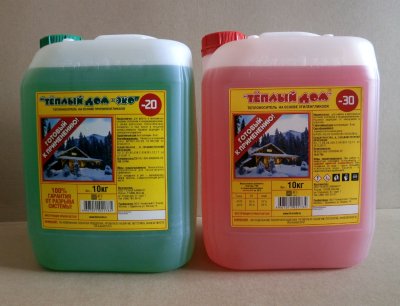
Antifreezes of this brand are available in two versions:
- "Warm House-65" — a heat carrier based on ethylene glycol, which ensures normal operation of the heating system in the temperature range from -65 °C to 112 °C.
- "Warm House-Eco" — used in any systems, but more often used in systems with increased requirements for environmental safety. Produced from imported propylene glycol, used in pharmacology.
Coolant composition depending on the freezing temperature in the region
"Teply Dom-65" in undiluted form is used only in conditions Far North, and in other regions it is first diluted with distilled water. To obtain the freezing point -40 °C, take 23% water and 77% antifreeze, For -30 °C - 35 and 65% water and antifreeze respectively. The upper limit of dilution is at the level -20 °C.
For areas in Central region the level at which the coolant begins to freeze is considered normal -30 °C. Dilution with water allows to increase heat capacity and improve circulation of antifreeze.
Which type is better to choose?
If the temperature in the system does not drop during the cold season below +5 °C, then the best heat carrier in this case is water, maximally purified from salts.
If long shutdowns of the heating system are possible in winter, then antifreeze would be the best option.
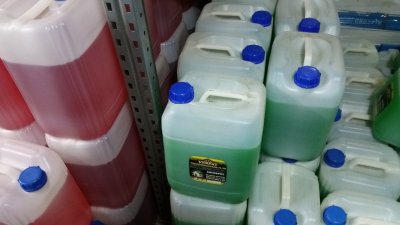
To choose the right antifreeze, consider the following points:
- worker temperature range;
- influence of coolant on materials of system parts (on ferrous and non-ferrous metals, plastic, rubber, etc.);
- duration cycle of use;
- safety for health.
Taking into account the last factor, it is recommended to use propylene antifreezes for heating the house.
Formula for calculating the required amount
To calculate how much coolant is required to fill the system, it is necessary to take into account the volume of all its components: pipes, radiators, boiler and expansion tank.
Calculation of pipe volume: V of pipe = L*S, Where L — the length of the pipe, and S — the area of its cross-section.
The volume of water in radiators is determined depending on their type.
| Type of radiators | Volume of coolant in one section, l |
| Aluminum | 0.45 |
| Bimetallic | 0.25 |
| Cast iron (new) | 1.0 |
| Cast iron (old) | 1.7 |
How to fill the system
The easiest way is to fill an open heating system with coolant. The coolant is poured into the expansion tank and under its own weight distributed throughout the system.
Important! Before you start filling, you need to open everything Mayevsky cranes to release air from the circuit.
The closed system is filled either by gravity, or with the help of submersible pump.
By gravity
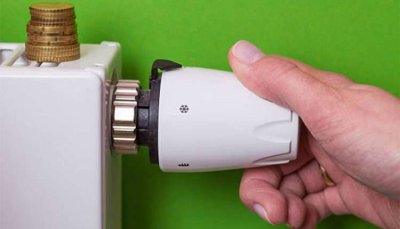
To pump fluid into the heating system by gravity, follow these steps:
- Find the most high point. Most likely, it will be some kind of gas vent that will need to be removed.
-
Connect a hose from the water supply to the entry point, or pour water into a barrel and lift it up above the entry level and pour it into the system.
The same method is used to fill in antifreeze. If you work with ethylene antifreeze, be sure to put on respirator and protective gloves. If the substance gets on fabric or other materials, dispose of them. When water starts flowing from the drain tap, it means the system is full.
After this, create the required pressure in the system:
- Attach a hose of length to the inlet. about 150 cm (choose the inlet so that it is possible to see the pressure gauge). Install a check valve and a ball valve at this point.
- Fill the hose with coolant, directing it up. Using an adapter, connect a car pump to the hose, open the tap and pump the coolant into the system. When almost all the contents of the hose are pumped into the system, close the tap and repeat everything again.
- Repeat the previous point until you reach the required pressure mark.
Filling with a submersible pump
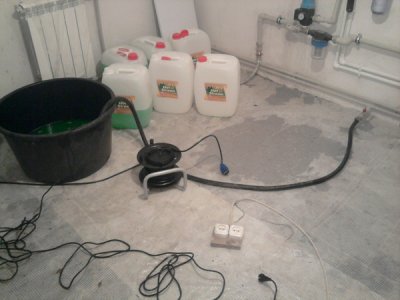
The coolant is pumped in much faster using a submersible pump low power. Connect the device to the lowest point (this should not coincide with the drain point).
Connect the pump by installing a ball valve and a check valve, install another ball valve at the drain point.
Pour the coolant into the tank, lower the pump there and turn it on (all air vents must be open). To prevent air from being pumped in, monitor the liquid level and add it to the tank if necessary.
Follow with a pressure gauge — the movement of its arrow will mean that the system is already filled. Close the valve and air vents. Let the pump work until the pressure rises to the required level.
After this, turn off the pump, close the tap and open the air vents, including on batteries. The air will come out, and the pressure will drop a little. Turn the pump on again and bring the pressure to the desired level, then release the air again. Repeat until air stops coming out of the bleeders.
Turn on the circulation pump and bleed the air again. If the pressure does not change, the system is ready for operation.
Is it possible to make it yourself from concentrate?
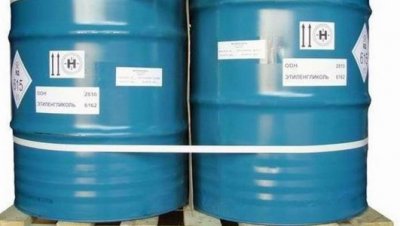
If for some reason you do not want to buy industrial antifreeze, you can make your own “antifreeze” from ethyl alcohol.
To do this, dilute it with distilled or regular tap water. up to a concentration of 33-55% depending on your climate zone.
This type of coolant is not suitable for open systems due to the high volatility of alcohol.
Useful video
Watch the video to learn how to properly fill the heating medium into the heating system.
What to look for when choosing
Before designing a heating system, decide what coolant will be used in it, since some design features depend on this. To operate on non-freezing liquid, you will need a larger expansion tank and larger diameter pipes.
Before installing radiators, disassemble them and make sure that paronite or Teflon gaskets are used. The same applies to other detachable connections, for threaded connections use flax tow and sealing paste. Instead of automatic air vents that are not designed for antifreeze, you will need Mayevsky taps.








